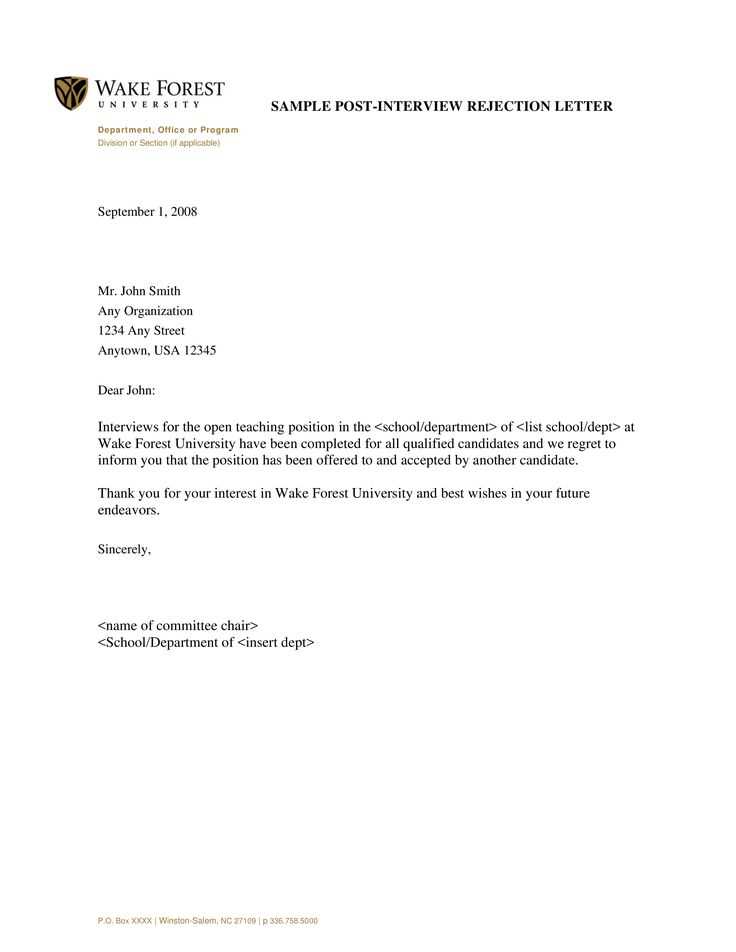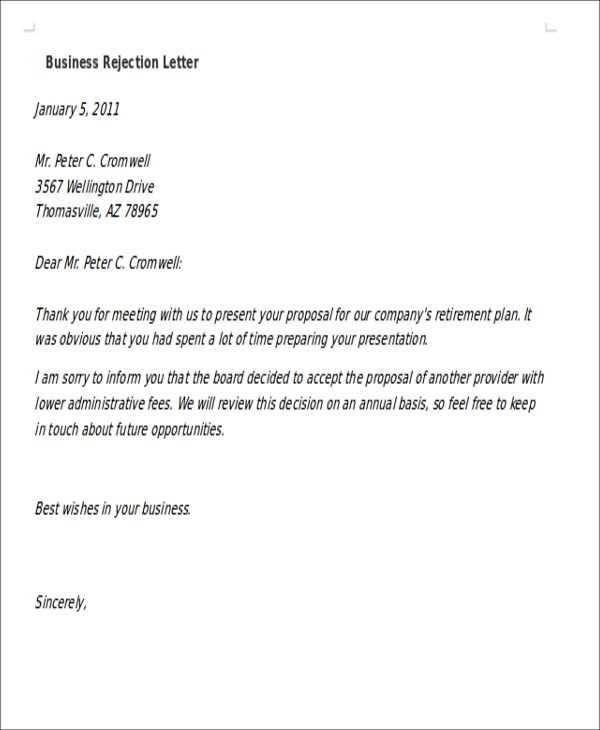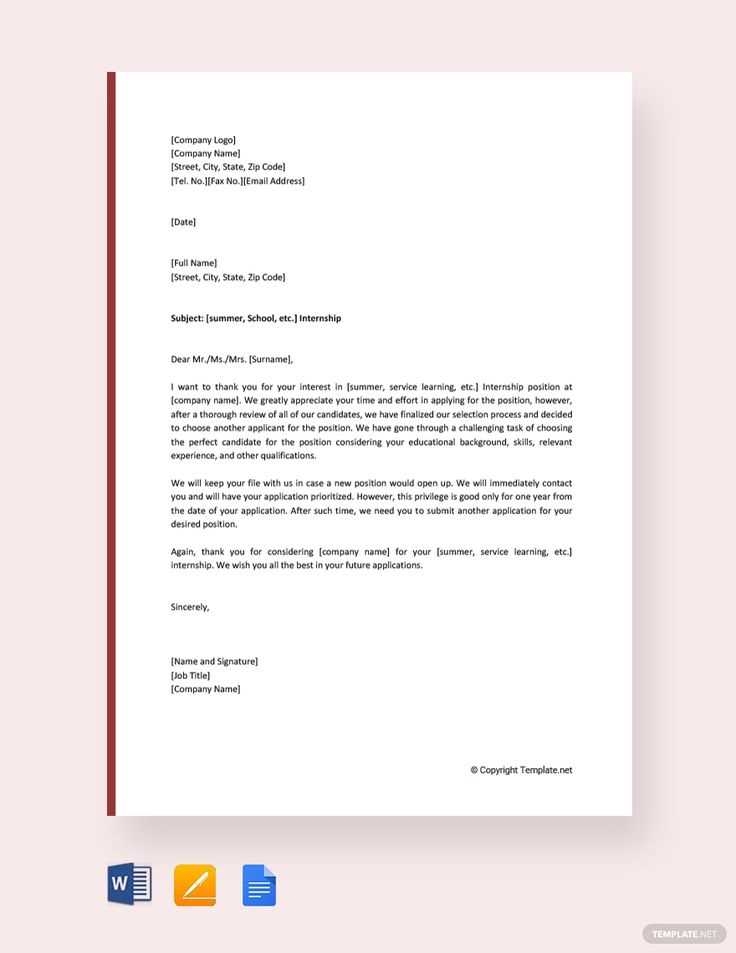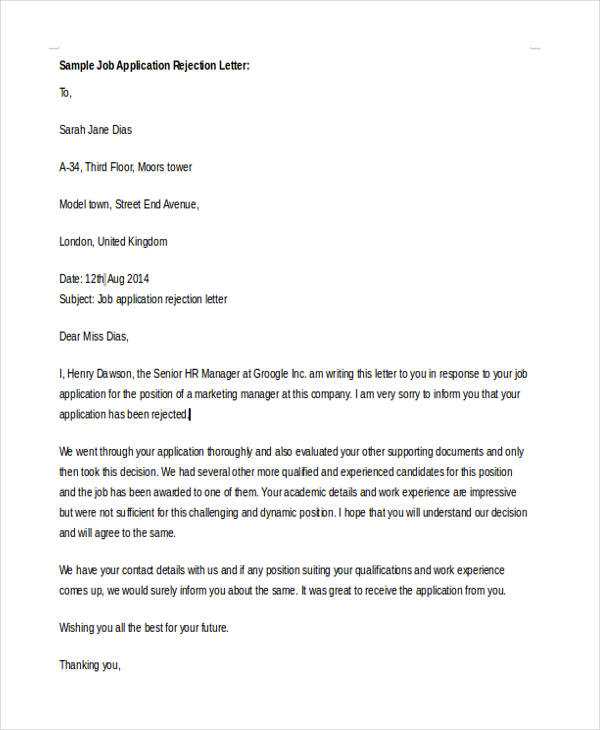Rejection letter template

Begin your rejection letter by clearly stating the decision. A simple and direct sentence ensures the message is conveyed without ambiguity.
Example: “Thank you for your application, but we have decided to move forward with other candidates.” This keeps the tone professional and respectful.
After the decision, it’s helpful to provide a brief explanation. This adds transparency without going into unnecessary detail. A general reason like “we selected a candidate whose qualifications better match our needs” works well.
Example: “While we were impressed with your qualifications, we have chosen another candidate whose experience more closely aligns with the position’s requirements.”
Close the letter on a positive note. Express appreciation for the applicant’s effort and wish them success in their future endeavors.
Example: “We appreciate the time and effort you put into your application and wish you the best in your job search.”
Rejection Letter Template: A Practical Guide

Begin with a polite greeting, addressing the recipient directly. Avoid overly formal language, and keep the tone respectful and professional. Acknowledge the applicant’s effort by briefly recognizing their qualifications or application.
Next, clearly state the decision. Be straightforward but gentle, ensuring the message is direct without sounding harsh. It’s important to provide the necessary information in a way that leaves no room for confusion.
Provide a reason for the rejection, but keep it brief and neutral. There’s no need for detailed explanations, but offering context can help the recipient understand the decision. Avoid personal or subjective judgments, focusing on business-related factors.
End on a positive note. Thank the applicant for their time and effort. Encourage them to apply again in the future, if applicable, or offer a few words of encouragement for their continued search. This helps maintain a positive relationship and leaves the door open for future opportunities.
Starting a Rejection Letter Professionally
Begin your rejection letter by acknowledging the recipient’s effort and time. Be straightforward yet polite, setting the tone for the rest of your message.
Use a Clear and Direct Opening
Start with a concise sentence that gets to the point, but in a considerate manner. For instance:
- “Thank you for your interest in the position at [Company Name].”
- “We appreciate the time you invested in applying for the [Job Title] role.”
Express Appreciation Sincerely
Recognize the applicant’s qualifications or experience to show respect for their efforts, even if the outcome is not favorable.
- “Your experience in [specific field] was impressive and we truly value your application.”
- “We were pleased to learn more about your skills and qualifications.”
Selecting the Right Tone for Your Rejection
Maintain professionalism and empathy when writing a rejection letter. Your tone should reflect respect for the recipient while clearly communicating the decision. It is crucial to strike a balance between being firm and compassionate.
Be Direct but Courteous
State the rejection clearly without ambiguity. Avoid using overly soft language that might create confusion. However, make sure the recipient feels respected by using polite phrases like “We appreciate your time” or “Thank you for your interest.” This helps soften the impact while still delivering the message clearly.
Avoid Negativity
Do not focus on the recipient’s shortcomings. Instead, concentrate on the fit between the individual and your needs. Phrasing like “Unfortunately, we do not think this opportunity aligns with your current qualifications” sounds constructive rather than harsh.
Key Elements to Include in a Rejection Letter
Begin with a clear statement that the application will not be moving forward. This ensures there is no confusion regarding the decision. Acknowledge the effort put into the application or interview to show appreciation for their interest.
Reason for Rejection
Be concise about the reason behind the rejection, but avoid unnecessary details. Whether it’s due to qualifications, experience, or another factor, provide enough context to make the decision understandable. Keep the tone professional and polite.
Encouragement for Future Opportunities
Invite the candidate to apply for other positions that might suit their skills in the future. This leaves the door open for further communication and shows that the rejection is not a reflection of their abilities but rather a matter of fit.
Close with a friendly, positive note. Express appreciation once again for their time and effort, wishing them success in their job search. A brief, respectful conclusion ensures the candidate feels valued despite the decision.
Personalizing Your Rejection Letter for Various Situations

Focus on addressing the specific circumstances of the candidate’s application. If the person was not selected due to lack of experience, highlight areas where they can improve. For instance, “While your background is impressive, the role requires more direct experience with project management.”
If the decision was based on a mismatch of skills or qualifications, be clear but supportive: “We appreciate your interest, but this position demands advanced skills in data analysis, which we’re seeking in a candidate.”
When rejecting a candidate for a role that may open again in the future, leave the door open without implying guarantees: “We will keep your details on file and contact you should another opportunity arise that matches your profile more closely.”
In cases where the rejection is due to the candidate’s fit within the company culture, ensure the tone remains respectful: “We believe the team dynamics for this role require a different skill set, but we were impressed with your enthusiasm and qualifications.”
For internal candidates, the approach should maintain professionalism while acknowledging their contributions: “Thank you for your continued dedication to the team. After careful consideration, we’ve decided to move forward with another candidate for this position, but your ongoing work is greatly valued.”
Avoiding Common Mistakes in Rejection Letters
Be clear and direct. Avoid using ambiguous language that may cause confusion for the recipient. A rejection letter should leave no room for misinterpretation.
- Don’t Use Clichés: Avoid vague statements like “It was a difficult decision” or “You’re a strong candidate.” These phrases don’t provide any helpful feedback or clarity.
- Be Specific, Yet Brief: You don’t need to elaborate on every reason for the decision, but giving a clear, short explanation shows respect for the recipient’s time and effort.
- Avoid Being Overly Personal: Focus on the professional aspects of the decision rather than personal attributes. For example, instead of “You didn’t seem passionate enough,” state “Your qualifications did not fully align with the job requirements.”
- Don’t Over-Apologize: While it’s important to be empathetic, excessive apologies can make the letter sound insincere. A simple “thank you for your time” is enough.
Consider the tone carefully. A rejection letter should be polite and respectful without being overly emotional or harsh. Keep it professional and neutral.
- Avoid Negative Language: Steer clear of terms that could be perceived as insulting or belittling. Focus on the fit between the candidate and the position rather than any personal shortcomings.
- Don’t Make Empty Promises: Avoid offering false hope, such as “We will keep your resume for future opportunities” unless you genuinely plan to do so. If not, it’s better to remain silent on this point.
Finally, give closure. End the letter on a note of gratitude. This helps the recipient feel respected and appreciated for their efforts.
Finalizing and Sending Your Rejection Letter

Ensure your rejection letter is clear, concise, and professional before sending. Proofread for grammar or spelling mistakes to avoid giving the wrong impression. Double-check the recipient’s contact details to ensure it reaches the intended person without delay.
Formatting Your Letter
Maintain a formal structure by using a professional font and clean layout. Avoid clutter and ensure there is enough spacing between paragraphs for easy reading. Here’s a sample format:
| Section | Details |
|---|---|
| Salutation | Address the person by their formal title and last name (e.g., Dear Mr. Smith). |
| Introduction | Briefly state the purpose of the letter and thank them for their application. |
| Body | Politely decline the request, offering a brief explanation without going into unnecessary detail. |
| Conclusion | End with well-wishes and offer to keep them in mind for future opportunities. |
Sending the Letter
Choose the appropriate medium for communication–email is usually the most effective method, but a printed letter may be more fitting for certain formal situations. Attach any necessary documents if required. Confirm the recipient has received the letter, especially in professional settings where follow-up may be necessary.